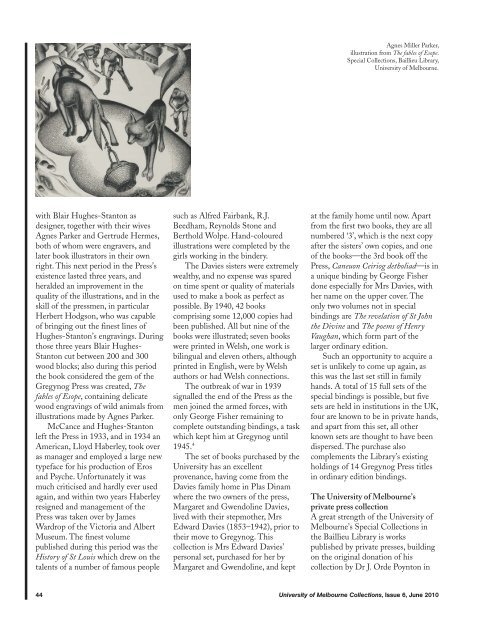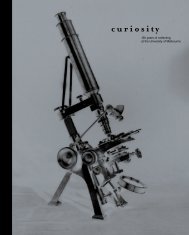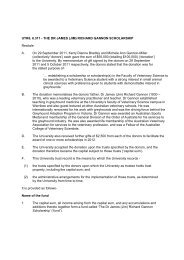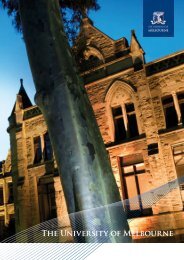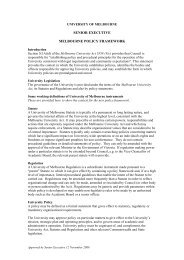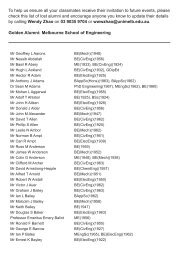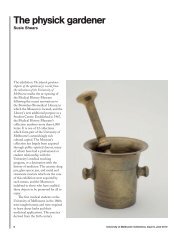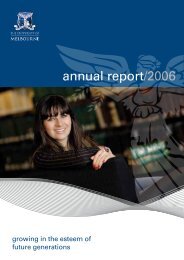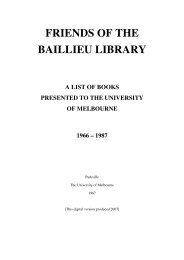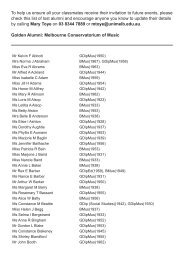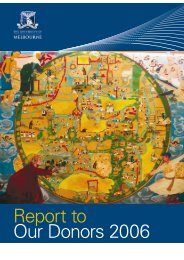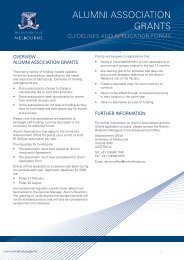COLLECTIONS - University of Melbourne
COLLECTIONS - University of Melbourne
COLLECTIONS - University of Melbourne
You also want an ePaper? Increase the reach of your titles
YUMPU automatically turns print PDFs into web optimized ePapers that Google loves.
Agnes Miller Parker,<br />
illustration from The fables <strong>of</strong> Esope.<br />
Special Collections, Baillieu Library,<br />
<strong>University</strong> <strong>of</strong> <strong>Melbourne</strong>.<br />
with Blair Hughes-Stanton as<br />
designer, together with their wives<br />
Agnes Parker and Gertrude Hermes,<br />
both <strong>of</strong> whom were engravers, and<br />
later book illustrators in their own<br />
right. This next period in the Press’s<br />
existence lasted three years, and<br />
heralded an improvement in the<br />
quality <strong>of</strong> the illustrations, and in the<br />
skill <strong>of</strong> the pressmen, in particular<br />
Herbert Hodgson, who was capable<br />
<strong>of</strong> bringing out the finest lines <strong>of</strong><br />
Hughes-Stanton’s engravings. During<br />
those three years Blair Hughes-<br />
Stanton cut between 200 and 300<br />
wood blocks; also during this period<br />
the book considered the gem <strong>of</strong> the<br />
Gregynog Press was created, The<br />
fables <strong>of</strong> Esope, containing delicate<br />
wood engravings <strong>of</strong> wild animals from<br />
illustrations made by Agnes Parker.<br />
McCance and Hughes-Stanton<br />
left the Press in 1933, and in 1934 an<br />
American, Lloyd Haberley, took over<br />
as manager and employed a large new<br />
typeface for his production <strong>of</strong> Eros<br />
and Psyche. Unfortunately it was<br />
much criticised and hardly ever used<br />
again, and within two years Haberley<br />
resigned and management <strong>of</strong> the<br />
Press was taken over by James<br />
Wardrop <strong>of</strong> the Victoria and Albert<br />
Museum. The finest volume<br />
published during this period was the<br />
History <strong>of</strong> St Louis which drew on the<br />
talents <strong>of</strong> a number <strong>of</strong> famous people<br />
such as Alfred Fairbank, R.J.<br />
Beedham, Reynolds Stone and<br />
Berthold Wolpe. Hand-coloured<br />
illustrations were completed by the<br />
girls working in the bindery.<br />
The Davies sisters were extremely<br />
wealthy, and no expense was spared<br />
on time spent or quality <strong>of</strong> materials<br />
used to make a book as perfect as<br />
possible. By 1940, 42 books<br />
comprising some 12,000 copies had<br />
been published. All but nine <strong>of</strong> the<br />
books were illustrated; seven books<br />
were printed in Welsh, one work is<br />
bilingual and eleven others, although<br />
printed in English, were by Welsh<br />
authors or had Welsh connections.<br />
The outbreak <strong>of</strong> war in 1939<br />
signalled the end <strong>of</strong> the Press as the<br />
men joined the armed forces, with<br />
only George Fisher remaining to<br />
complete outstanding bindings, a task<br />
which kept him at Gregynog until<br />
1945. 4<br />
The set <strong>of</strong> books purchased by the<br />
<strong>University</strong> has an excellent<br />
provenance, having come from the<br />
Davies family home in Plas Dinam<br />
where the two owners <strong>of</strong> the press,<br />
Margaret and Gwendoline Davies,<br />
lived with their stepmother, Mrs<br />
Edward Davies (1853–1942), prior to<br />
their move to Gregynog. This<br />
collection is Mrs Edward Davies’<br />
personal set, purchased for her by<br />
Margaret and Gwendoline, and kept<br />
at the family home until now. Apart<br />
from the first two books, they are all<br />
numbered ‘3’, which is the next copy<br />
after the sisters’ own copies, and one<br />
<strong>of</strong> the books—the 3rd book <strong>of</strong>f the<br />
Press, Caneuon Ceiriog detholiad—is in<br />
a unique binding by George Fisher<br />
done especially for Mrs Davies, with<br />
her name on the upper cover. The<br />
only two volumes not in special<br />
bindings are The revelation <strong>of</strong> St John<br />
the Divine and The poems <strong>of</strong> Henry<br />
Vaughan, which form part <strong>of</strong> the<br />
larger ordinary edition.<br />
Such an opportunity to acquire a<br />
set is unlikely to come up again, as<br />
this was the last set still in family<br />
hands. A total <strong>of</strong> 15 full sets <strong>of</strong> the<br />
special bindings is possible, but five<br />
sets are held in institutions in the UK,<br />
four are known to be in private hands,<br />
and apart from this set, all other<br />
known sets are thought to have been<br />
dispersed. The purchase also<br />
complements the Library’s existing<br />
holdings <strong>of</strong> 14 Gregynog Press titles<br />
in ordinary edition bindings.<br />
The <strong>University</strong> <strong>of</strong> <strong>Melbourne</strong>’s<br />
private press collection<br />
A great strength <strong>of</strong> the <strong>University</strong> <strong>of</strong><br />
<strong>Melbourne</strong>’s Special Collections in<br />
the Baillieu Library is works<br />
published by private presses, building<br />
on the original donation <strong>of</strong> his<br />
collection by Dr J. Orde Poynton in<br />
44<br />
<strong>University</strong> <strong>of</strong> <strong>Melbourne</strong> Collections, Issue 6, June 2010


